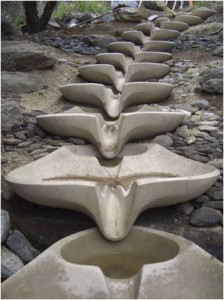“It’s like driving a car at night. You never see further than your headlights, but you can make the whole trip that way.” – E.L. Doctorow
I have a terrible habit of using car metaphors when I talk about water governance. I can’t say it is climate-friendly connection, but they come out of nowhere to carry the conversation.
In a previous post, I talked about our quandary: needing to collaborate and make decisions about water, and not having a formal structure to work with. The government of BC has recently invested in several reports on governance as part of Water Act Modernization, and the end result is likely to be “enabling legislation.” That is, the ability to establish a watershed organization under law, without specifying what form it takes or authority it holds.
This is when we all start talking about vehicles for moving forward. To a certain extent, everyone would like to engineer some kind of ideal vehicle for watershed management – a car of the future that can make it through any terrain. We take this conversational detour, even while repeating “one size doesn’t fit all.”
My own feeling is that starting with enabling legislation is probably the best thing. Why would we invest in a fancy new Ferrari (or Hummer) when we haven’t tested how far we can go with our old Ford? The Okanagan Basin Water Board, the Fraser Basin Council, and the Columbia Basin Trust are three different models with very different features, each being road-tested in BC. Even though they’ve all been around for a number of years, each is moving into new water management responsibilities, and trying new things.
The bottom line is that we are collectively looking for a set of basic characteristics that make a watershed organization work – tuned up and running smoothly down the road.
What are the first principles?
When I am asked to talk to different groups about how we operate in the Okanagan, and what’s working, I usually focus on the following basic points, but I’m sure there are more to add:
- Secure base funding from property taxes or other completely reliable source. You can’t be a reliable service provider without a consistent operational budget
- The corollary is to only rely on government grants for projects, not operations
- Having professional, well-trained staff is essential – this is the first thing to invest in, and they will make the connections, bring people together, secure grants, and get projects done.
- You must start by building support within your local community – especially elected officials who are there to represent the community as a whole. There is no way to have a functional watershed management organization without the support of local government.
- It is essential to have the support and good communication with local First Nations governments – there will be many changes in the coming years related to First Nations rights and title to water, and they have a different role than either local governments or water stakeholder groups.
- Be very clear on the extent of your mandate and authority, and work to understand the mandate and authority of other levels of government.
- Be inclusive: everyone has the same end goal – a clean and healthy environment with adequate water supplies for humans and animals – we just approach the problem from different angles.
- Be patient, because the process of building trust and understand the needs of each community or sector takes time.
- Be confident and innovative. The world is changing, and change is complicated to navigate.
- Be positive, be friendly, eat together, and trust that you are making progress.
In summary, if I were to design enabling legislation, at the most basic level, it would make watershed governance organizations financially self-supporting, and would clarify the mandate and authority of watershed groups relative to the local governments in their regions. There would also be some form of democratic process – either where elected officials are appointed to the board, or through direct elections. In my mind, these form the steel frame and underpinning of a vehicle for any terrain.
In the Okanagan, our legislation specifies an appointed board of elected officials with decision-making authority, and also a liaison committee, the Okanagan Water Stewardship Council, that creates a strong connection to the community of water professionals and water sectors.
There are many ways to customize the basic framework for a watershed governance vehicle, to make it better suited to the different watershed types and different community needs in BC. The other bullet points in my list are essentially driving tips for getting it down the road.




Pingback: Everything you wanted to know about watershed governance | Building Bridges